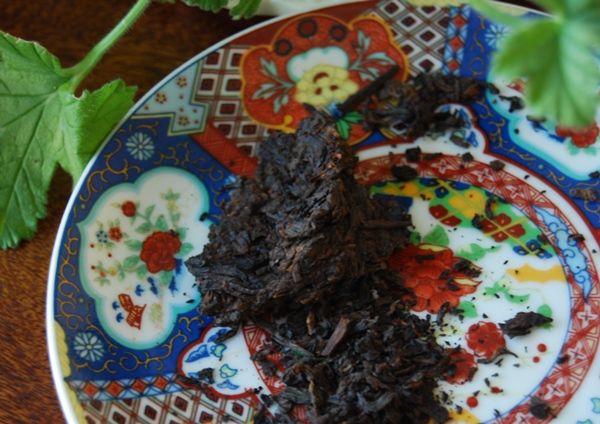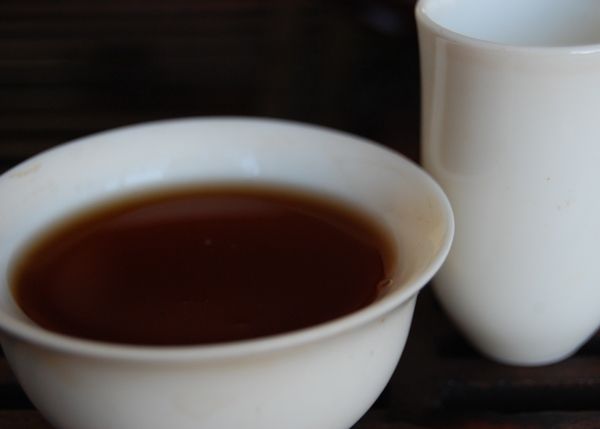There's nothing more enjoyable when it comes to tea than some great leaves given as a kind gesture - ideally, taken with friends, but, if not, then appreciating the tea alone has its own magic.
A teachum most musical took pity on us, miserable offenders, with a rather large chunk o' CNNP from the 1980s.
To HC, many thanks for a clutch of fantastic sessions. This arrived just as I was about to run dry of samples to drink, for the first time in many years...
When it comes to "1980s CNNP", we must appreciate that we are dealing with a wide spectrum: CNNP was the state entity responsible for "marketing" pu'ercha in the 1980s (if one does indeed "market" under Communism proper), and ten years is a long time. Even in my most limited experience, I have been fortunate enough to try not one but four teas that could be classified as "1980s CNNP", excluding various Menghai Qingbing.
You've got to admire the figurative cojones of HC, who bought this 1980s from eBay - that's a decision not lightly to be taken, and requires a will of iron - there is much fakery around when it comes to mature pu'ercha.
The leaves, pictured above, look credible, do they not? They're small, black, and (though you might struggle to determine this from the photograph) they have a delicately sweet scent.
All fears abate when faced the dark density of the soup. Shown above, this is a rich, burgundy-coloured affair that sits as well in the stomach as you might imagine. Testament to HC's purchasing skills, it endures and has retained a significant potency, giving a most satisfying tangy presence in the throat that indicates good leaves. It is hard to fake that depth-of-character.
The powderlike texture and the gently floral character remind me of Toki's and His Grace, the Duke of N's descriptions of "granny powder", which I assume to mean the traditional powder used during an older lady's morning preparations. It reminds me of the scent of my own dear grandmother, at least, from my childhood.
Perhaps I should let you into a little secret, which I am sure is obvious: it's almost impossible to overbrew old tea. For those crazy, mindless fools (such as your humble correspondent) who spend the majority of their tea-time in hand-to-hand combat with young shengpu, the robustness and lack of aggression in old teas can seem like quite a change-of-pace, and a welcome one at that. I use plenty of leaves - the entire sample, in fact, and am rewarded with a thick, enduring soup that lasts forever.
HC, I am most grateful for this excellent experience - thanks again.



5 comments:
That cakes sounds tasty. Is it the 1988 cake currently selling on ebay? Price seems too good to be true.
Dear Anonymous,
I'm afraid I don't know which cake that this was on eBay, but it'd be nice to know! I enjoyed it very much. Sometimes, the situation calls for some proper, aged shengpu.
Toodlepip,
Hobbes
That eBay cake mentioned above has samples available to taste ... for 29.00 you get. 60 grams. So if someone wanted to check it out...
Dear Hobbes,
I would like to ask you for advice as my personal shengpu grandmaster.
I know this is wrong question for the topic, but I am starting my shengpu collection and I wanted to acquaire some 8582.
Should I start collection by buying all 7-bing stacks of puers or is it better to order 2-3 from different years? Could you also tell me what is the difference in the quality of 8582 when it comes to batches 001-005?
Thanks in advance for your response!
Dear Aluoben,
If I'm your "grandmaster", you're in deep trouble. :)
8582 is a bit of a gamble - it has changed significantly over the years. The "Dayi" recent versions are substantially different to the Menghai / CNNP years. I have been going quite slowly with both 8582 and the other numbered recipes. That said, tasted on their own, they are powerful those that I have bought have aged well. I would humbly suggest against putting "all of your eggs in one basket", and therefore "spread your bets" to several years.
The batch numbers are produced in chronological order; so, the earliest batch in the year (typically produced with the first flush of spring maocha) is 001. Typically, the early spring batches are more potent, more desirable, and consequently more costly. I tend to buy only 001, just to be on the safe side. When buying older recipe cakes, that may not be possible - I have some 002 - 007 cakes from past years in my collection, bought aged.
Toodlepip,
Hobbes
Post a Comment